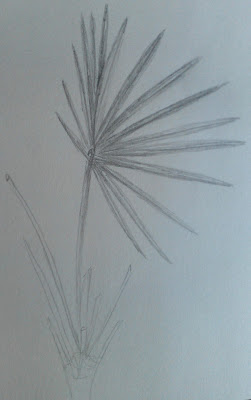January 14, 2013
This day was spent in the Arboretum here on the university's campus. It's generally a garden that has been tended by the students here.
 |
| The Arboretum's Pavilion |
Around 9:45 AM this is what I wrote in my sketchbook about the environment:
The day is cool, around 77 degrees F (according to my cell phone) with partly cloudy skies. There is a slight breeze but otherwise still. The sun is just beginning to break through the clouds.
I'm seated in the Arboretum's pavilion in one of the four wooden benches. The pavilion has climbing plants on the walls and roof which is attracting multiple black and yellow butterflies. Surround the pavilion are more butterfly plants with the same butterflies and small flying insects. The paths in the Arboretum are unkempt and full of small holes and green crawling plants and weeds.
The butterfly I was observing was this one:
Zebra Longwing,
Heliconius charitonius, Florida's state buttefly
 |
| Source: http://www.flheritage.com/facts/symbols/symbol.cfm?id=5 |
 |
| My own photograph of the Zebra Longwing from the Arboretum. |
As I wandered the Arboretum for something to concentrate on drawing, which was our assignment, I came across a plant that is familiar to me: the Tropical Milkweed, Ascelpias curassavica.
 |
| Tropical Milkweed |
I decided to focus my drawing on this plant. I noticed that it had multiple flowers and seed pods, a few of which were opening. From my past experience with this plant I know that it is poisonous to most animals except a few caterpillars, one of which being the Monarch, Danaus plexippus.
 |
| A opened and closed seedpod from the Tropical Milkweed. |
 |
| Photograph of the seedpod I was studying. |
 |
| Up-close of an individual seedpod from the Tropical Milkweed with the fibers. |
 |
| Detail of a leaf from the Tropical Milkweed. |
After investigating the plant for some time, a Monarch butter fly approached the plant on numerous occasions and I realized that it was laying eggs on the leaves:
 |
| Eggs laid by the Monarch butterfly on the Tropical Milkweed. Small cream-white colored with an oval shape. |
 |
| Monarch butterfly laying eggs on the Tropical Milkweed. You can see its abdomen touching the underside of the leaves to lay the eggs. |
I was very excited to see the butterfly and took numerous additional photos of the butterfly and the eggs. I was also very excited to find a few small caterpillars on the plant.
I described them in my sketchbook: Upon further investigating the eggs, I did notice multiple caterpillars of two sizes, two larger ones and at least four smaller ones. The caterpillars are generally underneath the leaves and are yellow black and white in color with black antennas. They have two pointed front "feet" and an additional 8 "feet pads" that stick to the leaves.
 |
| Young Monarch caterpillar on Tropical Milkweed. |
 |
| Large Monarch caterpillar on Tropical Milkweed. |
Overall, I enjoyed the day in the Arboretum and studying the Monarch caterpillars and butterflies. As the blog will show I continued to visit the Milkweed plant over several days to continue studying the caterpillars in hope of finding a chrysalis - the stage in which the caterpillar forms into a butterfly.



















































